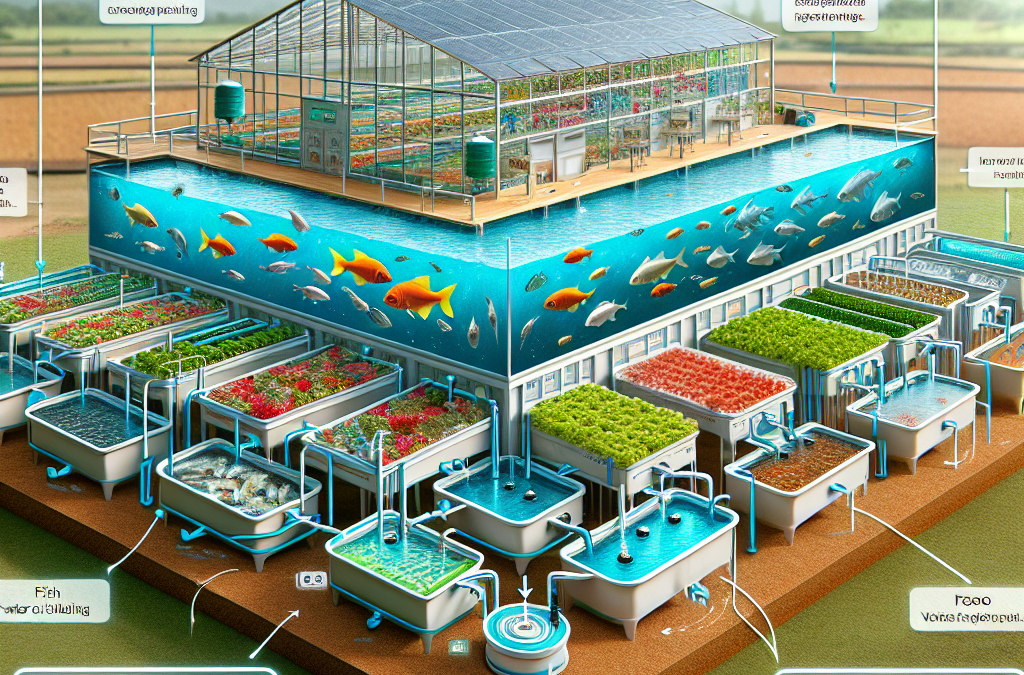Understanding the Basics of Aquaponics
What is Aquaponics?
You might be wondering, what exactly is aquaponics? Well, it’s a fascinating system that combines aquaculture (raising fish) with hydroponics (growing plants in water). Think of it like a self-sustaining ecosystem where the waste produced by fish acts as nutrients for the plants, and in return, the plants help filter the water for the fish. It’s a beautiful partnership, and let me tell you, it can be quite rewarding!
Setting up this system brings together nature and agriculture in a way that is both sustainable and efficient. You can grow fresh vegetables and protein-rich fish all in your backyard! How cool is that? The beauty of aquaponics is that you can have a constant cycle of growth and production with minimal waste.
Once you dive into aquaponics, you’ll find that it’s not just a growing method; it’s a whole lifestyle! You’re not just nurturing fish and plants—you’re creating a thriving ecological community right in your backyard. Some might say it’s like having a miniature farm.
Why Raise Fish and Livestock Together?
Raising fish and livestock together can really save you time and energy while maximizing productivity. When you combine these practices, you’re allowing nature to do part of the work for you. You’ll soon realize how interconnected everything is. The fish provide nutrients, the plants help clean the water, and, if you include livestock like chickens or ducks, they can help with pest control!
Imagine waking up every day, knowing that you have fresh fish and organic veggies at your fingertips. It’s like being a modern-day farmer with all the benefits but less fuss. Plus, there’s something incredibly satisfying about pulling fresh produce directly from your system. You can literally taste the freshness!
Plus, consider the benefits to the environment. By practicing aquaponics, you’re reducing the need for chemical fertilizers and pesticides, which is a win-win for both your health and the planet. You’ll feel good knowing that you’re doing your part in fostering sustainability!
Basic Components of an Aquaponics System
Now, let’s talk about the essential parts needed to get your aquaponics journey rolling. You’ll need a fish tank, grow beds, a sump tank, and pumps to keep the water flowing. Don’t worry; it sounds more complicated than it actually is. Setting this system up is like putting together the pieces of a puzzle!
The fish tank is where your aquatic friends will live and thrive. You can choose from a variety of fish such as tilapia, catfish, or trout—just make sure they’re suitable for your climate and system size. Then, you have your grow beds, where the plants will flourish. It’s where the magic happens!
Lastly, pumps and plumbing are used to circulate the water between the fish and the plants—keeping everything in harmony. Once these components come together, you’ll be amazed at how quickly life springs up around you! Don’t worry if it takes a little time to grasp it all. Practice makes perfect.
Choosing the Right Fish and Plants
Selecting Fish for Your System
When you’re starting out in aquaponics, selecting the right type of fish is crucial! Not all fish are created equal, and their compatibility with the plants and overall system is key. I’ve found that tilapia is a popular choice—especially if you live in warmer climates. They’re hardy, fast-growing, and tasty!
But maybe you want to try something different? Catfish can be great as well, particularly if you enjoy a milder flavor and are looking for a fish that’s pretty resilient. Just gather some info on their specific care needs and ensure your system can accommodate them.
Ultimately, choose fish that’ll fit well within your climate, system size, and your personal preferences. Doing a little research ahead of time can spare you a lot of headaches down the line, trust me on this one!
Growing Plants with Your Fish
Now let’s get to the fun part: choosing plants! You’ve got so many options at your fingertips, it can honestly be overwhelming. Leafy greens like lettuce and spinach are fantastic to start with because they thrive in aquaponics systems and have relatively quick growth cycles. Plus, they’re super healthy!
Herbs like basil, mint, and cilantro also do remarkably well in aquaponics systems. There’s nothing quite like having fresh herbs at hand for cooking, and they can elevate your meals to a whole new level. Just like the fish, select plants that you and your family actually enjoy eating!
Ultimately, it’s all about experimentation. Don’t be afraid to try growing a variety of plants and see what thrives in your unique setup. Each growing season can be a new adventure, and it’s a great way to learn what your system can produce.
Maintaining Balance in the System
Maintaining balance in your aquaponics system is vital for the health of your fish and plants. You’ll want to keep an eye on water quality, pH levels, and nutrient levels. It can feel like a bit of science class at first, but you’ll get the hang of it! Ensuring the water is clean and properly cycled is fundamental.
I recommend regularly testing your water parameters with a simple kit. This will keep you informed about what’s going on in your system. If the fish are happy and the plants are thriving, you’ll know you’re on the right track!
Additionally, don’t forget to feed your fish and occasionally prune your plants. It wouldn’t hurt to snag a little education on fish feeding strategies or plant care tips along the way. It might sound tedious, but you’ll be proud each time you notice your system flourishing!
Harvesting and Enjoying Your Produce
Timing Your Harvest
Harvesting in an aquaponics system is truly rewarding. But how do you know when it’s the right time? For fish, like tilapia, you can usually harvest them when they reach about a pound in weight. This can vary based on your specific system and feeding schedule, but be patient; your hard work will pay off!
For plants, timing often depends on the type you are growing. Leafy greens can usually be harvested within a few weeks, while fruiting plants may take a bit longer. A good rule of thumb is to keep an eye on their size and color—the more vibrant, the more ready they usually are!
Ultimately, it’s all about trusting your instincts. As you become more familiar with your system and your plants’ development, you’ll feel more confident and will know just when to harvest those delicious goodies!
Enjoying Fresh Produce
There’s nothing like the feeling of enjoying what you’ve grown yourself. The best part? You can include both your fresh fish and garden goodies in your meals! Picture this: a lightly grilled tilapia alongside a vibrant salad made from your own greens and herbs. It’s like having a five-star restaurant meal at home!
Not only does it taste amazing, but you’ll also feel a sense of accomplishment knowing you’ve nurtured it from scratch. And hey, you can even invite friends and family over for a dinner party to show off your aquaponics prowess!
Take time to experiment with recipes that incorporate your homegrown harvest. You’ll likely discover new favorites in the process. Cooking with fresh veggies and fish offers flavors you just can’t get from store-bought products, plus you’ll impress anyone lucky enough to share a meal with you!
Sharing and Scaling Up
Once you get the hang of your system and see how much you can produce, don’t hesitate to share your harvest. Neighbors, friends, and family will be thrilled to enjoy your aquaponics bounty. Plus, they might have some stories or tips to share from their own experiences.
If you have the space and the passion, consider scaling up. Maybe you want to add a second fish tank or expand your garden beds! The possibilities are endless, and as you dive deeper into aquaponics, you’ll find that there’s always something new to learn and explore.
Ultimately, the joy of aquaponics lies not just in the products you grow but in the process and connections you make along the way. Embrace the journey, and don’t be shy about sharing your passion with others!
FAQs
1. What fish are best for beginners in aquaponics?
Tilapia and catfish are popular choices for beginners due to their hardiness and fast growth rates. They are relatively low-maintenance and adapt well to different environments.
2. Can I grow fruiting plants in an aquaponics system?
Absolutely! You can grow fruiting plants, but they usually require a bit more time and care. Make sure to choose varieties that are compatible with your system.
3. How often should I feed my fish?
Typically, feeding fish once or twice a day is sufficient. Be careful not to overfeed, as that can lead to poor water quality. Monitor their behaviors to gauge their hunger.
4. How do I maintain water quality in my aquaponics system?
Regularly monitor pH levels, nutrient concentrations, and the ammonia/nitrite/nitrate levels through testing kits. Keeping these levels stable is crucial for the health of both fish and plants.
5. Is aquaponics sustainable?
Yes! Aquaponics is a sustainable practice as it minimizes waste, reduces the need for chemical fertilizers, and uses significantly less water compared to traditional farming methods, making it a great choice for environmentally conscious growers.





